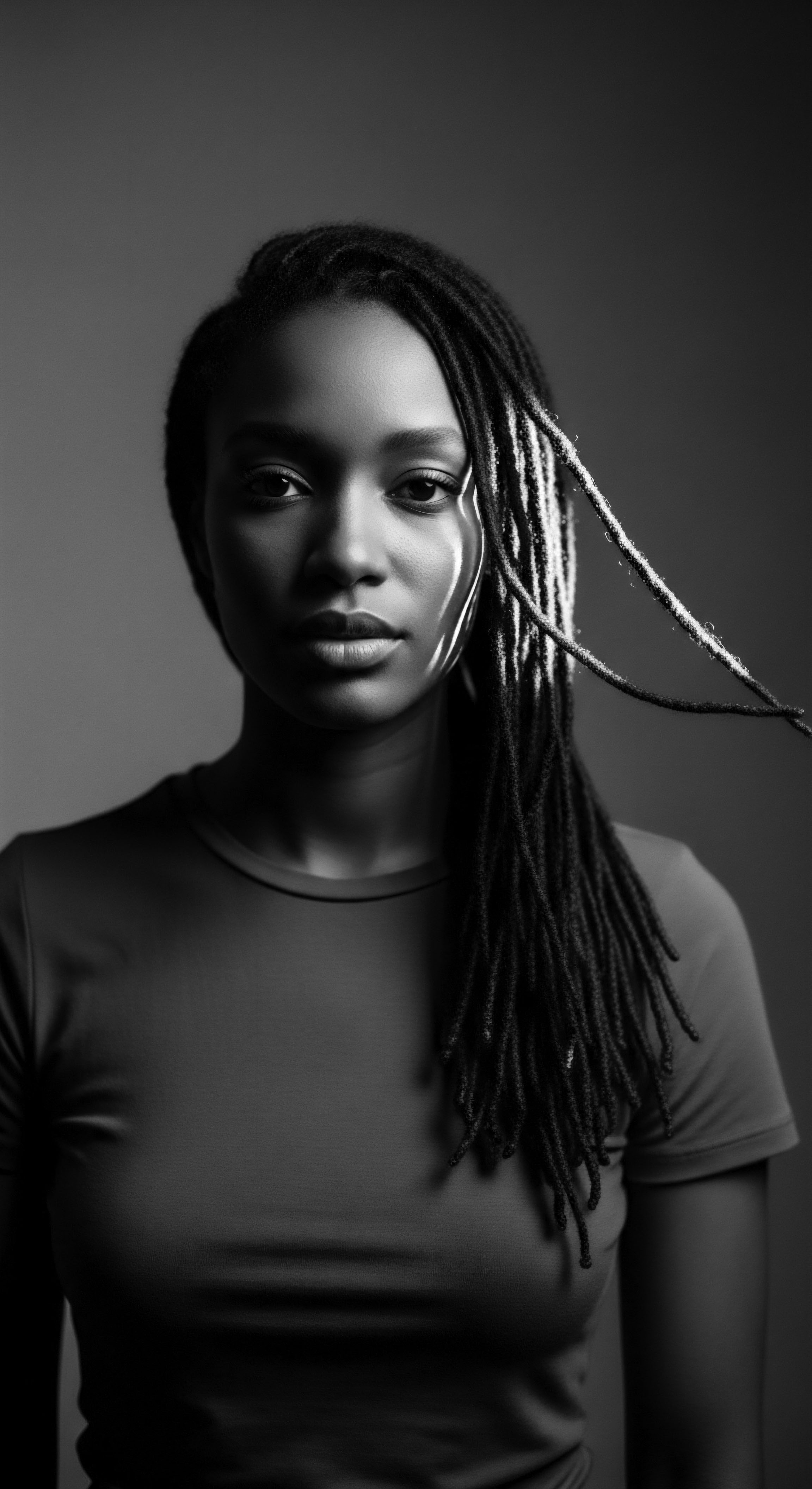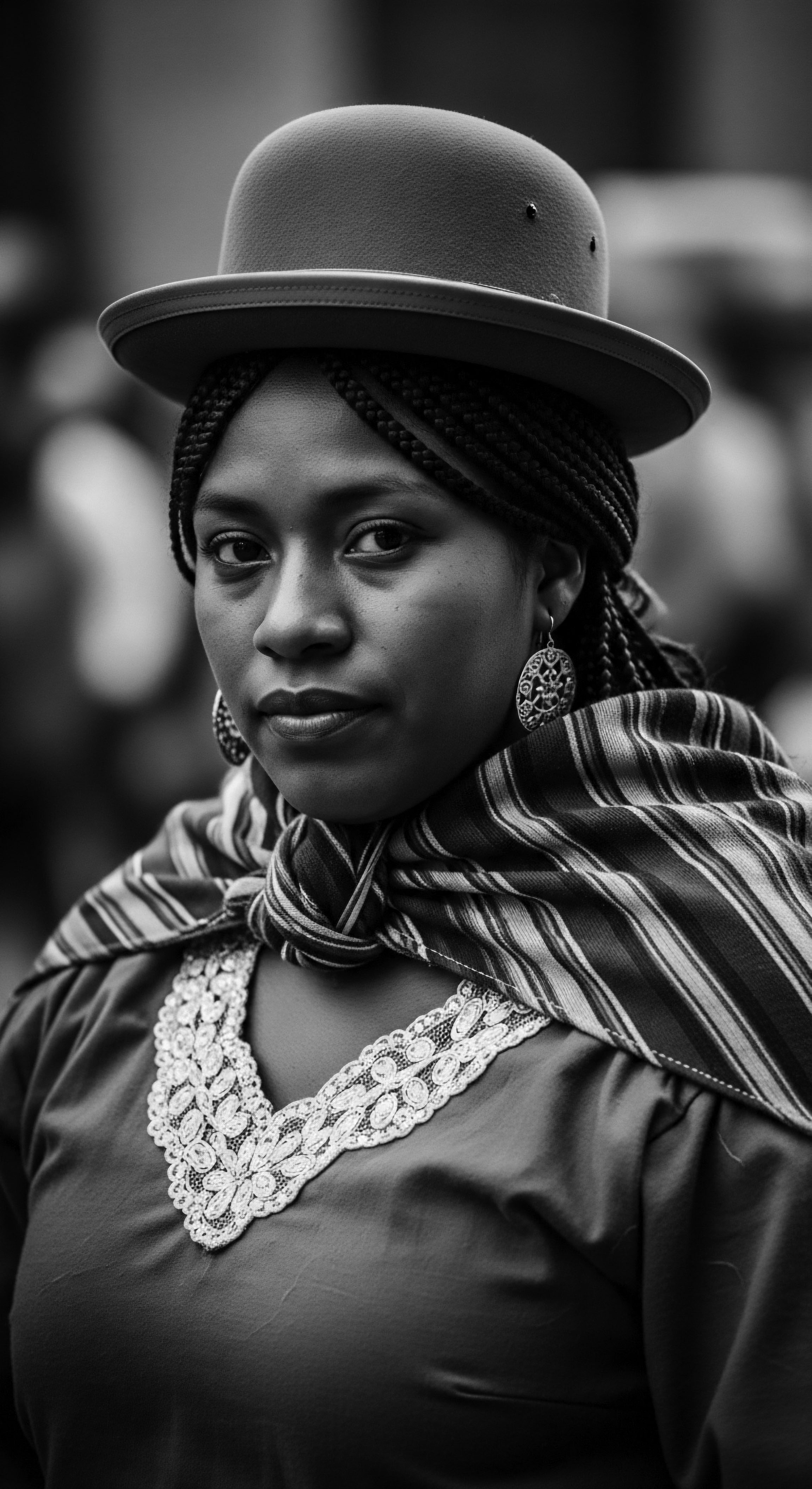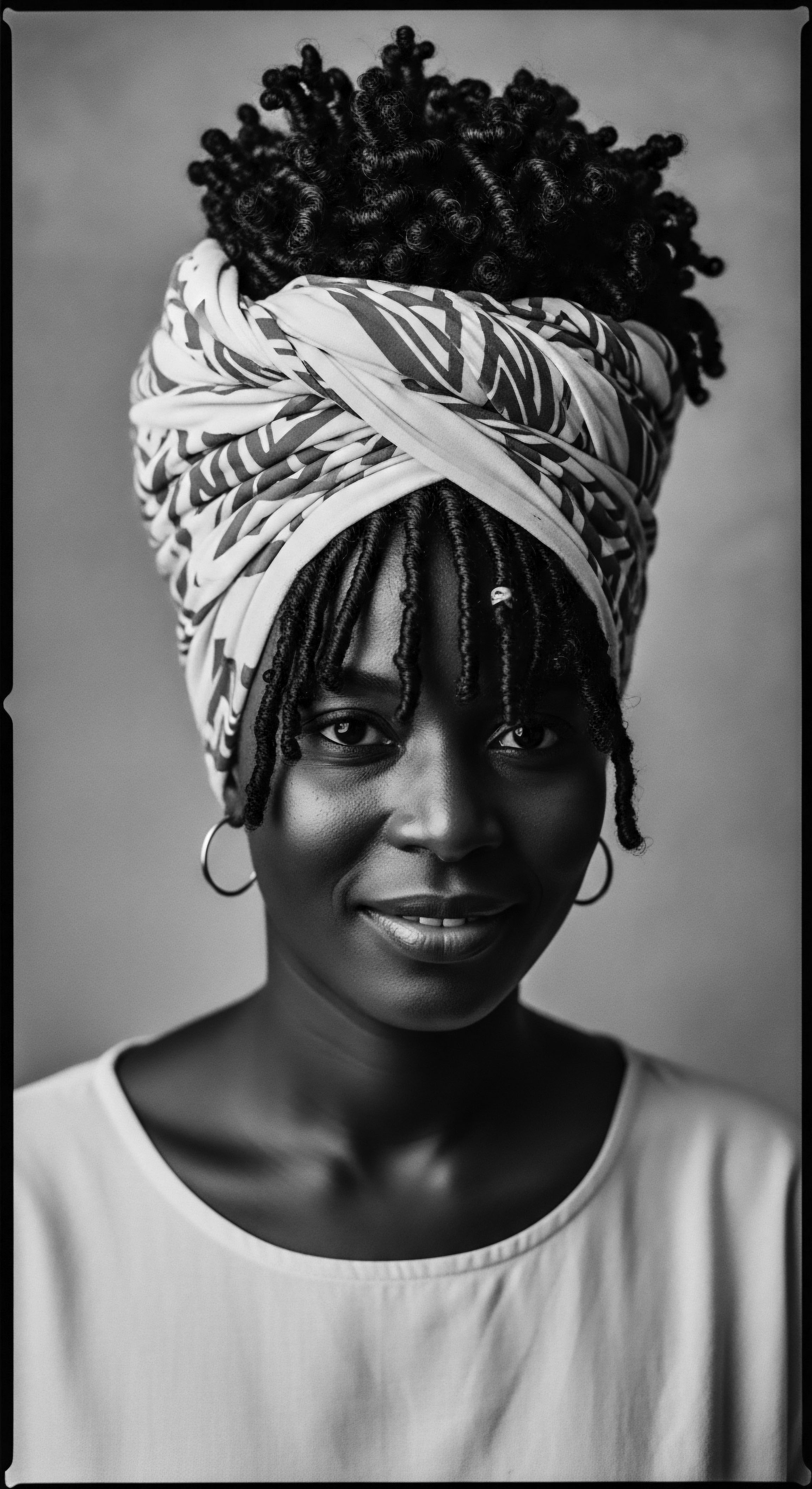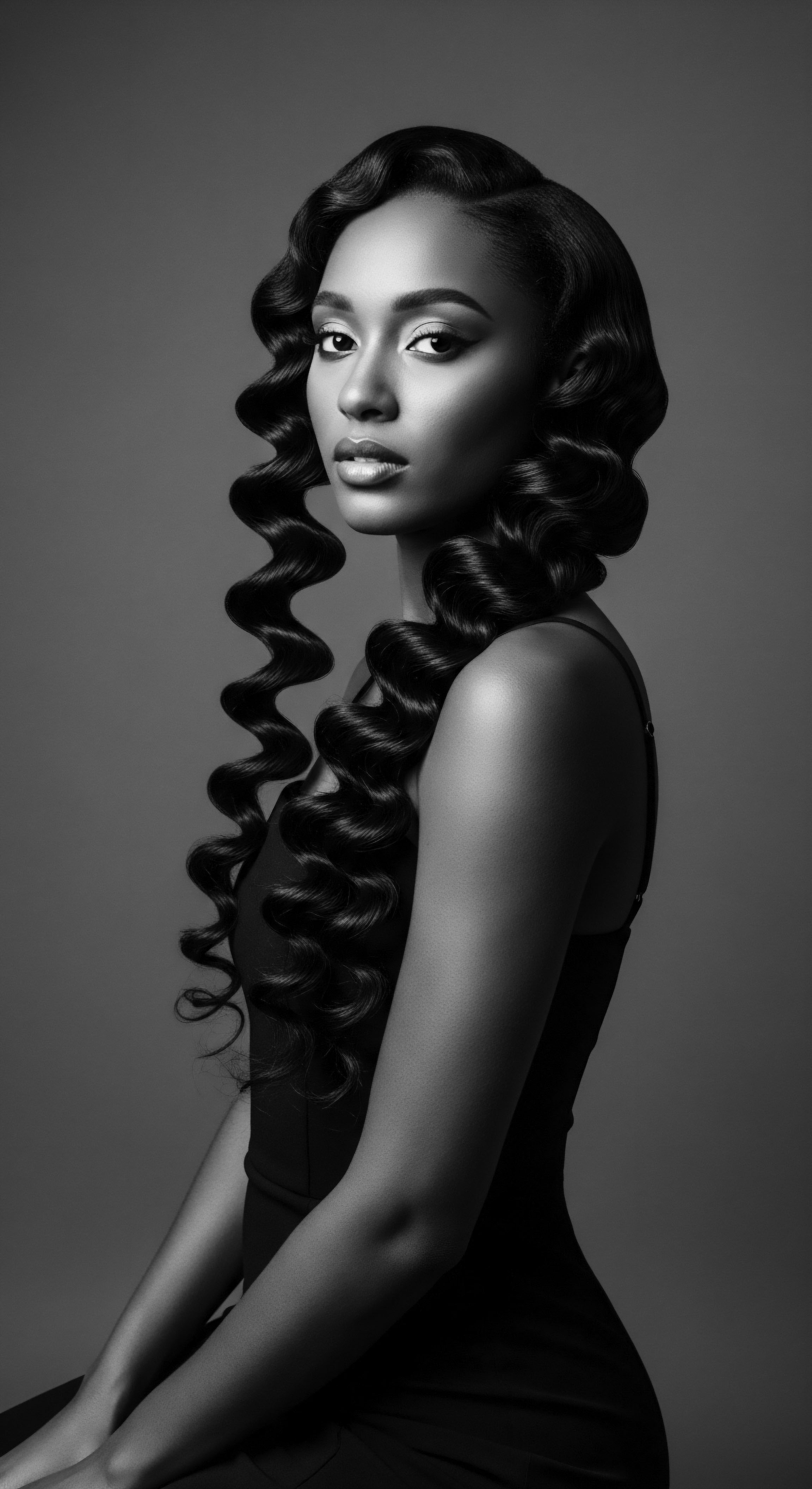
Roots
The deep story of hair strength and growth within Black heritage stretches back across continents and centuries, touching the very soul of identity. It is a narrative written not just in follicles and strands, but in the collective memory of communities, in the whispered wisdom passed through hands, in the quiet reverence for earth’s bounty. For those with textured hair, this connection to botanical traditions runs as deep as the ancestral currents that shaped their very being. To truly understand which historical botanical ingredients foster hair strength and growth in Black heritage, one must first listen to the echoes from the source, recognizing hair not as a mere adornment, but as a living archive of self, culture, and resilience.

The Ancestral Understanding of Hair
Across various African societies, hair was a language unto itself, communicating status, age, marital state, tribal affiliation, and even spiritual connections. The care of hair, then, became a sacred act, a communal ritual where botanical elements were not simply applied, but lovingly blended and infused with intention. Before the disruptions of transatlantic slavery, the natural world provided a pharmacy of profound remedies, meticulously gathered and prepared.
The hair itself, with its unique coil and curl, held deep symbolism, often described as a medium through which to connect with the spiritual realm. Styles communicated a silent narrative, reflecting the wearer’s place within society, a practice documented in anthropological studies across the continent.
Hair care in Black heritage is more than cosmetic; it is a profound dialogue with ancestral wisdom and the earth’s nurturing power.

Botanical Beginnings on the Continent
The vast landscapes of Africa offered a rich diversity of plants, each holding unique properties for scalp health and hair vitality. Early practices recognized the need for both cleansing and conditioning, often turning to plant-based solutions that preserved the hair’s natural moisture. For instance, in West Africa, the prominence of Shea Butter, derived from the nuts of the Vitellaria paradoxa tree, stands as a testament to this deep understanding.
It has been a moisturizer for hair and skin for centuries, prized for its fatty acids and vitamins that protect hair from environmental elements. This butter was not merely a product; it was a communal asset, often processed and used in ways that strengthened community bonds.
Another remarkable example comes from Chad, where the Basara Arab women traditionally use a mixture known as Chebe Powder. This unique blend, often comprising ingredients such as Croton zambesicus, Mahllaba Soubiane (cherry kernels), cloves, resin, and stone scent, is applied to the hair shaft rather than the scalp. Its purpose centers on length retention through prevention of breakage and moisture sealing, a testament to ancient practices focused on preserving the hair’s integrity. The effectiveness of Chebe powder is not in directly growing hair from the scalp, but in its ability to fortify strands, allowing them to reach remarkable lengths by preventing common issues like splitting and breakage.

Diverse African Botanicals for Hair Health
A significant number of plants from various African regions contribute to hair care traditions. Research has identified 68 plant species used in African hair treatments, addressing concerns from alopecia to dandruff. Many of these species, particularly those from families like Lamiaceae, Fabaceae, and Asteraceae, hold potential not only for hair conditions but also for systemic wellness, suggesting a holistic view of health that includes hair vitality.
- Palm Oil ❉ From its origin in the oil palm tree (Elaeis guineensis Jacq.), this oil has been traditionally employed in some African communities to soften hair and nourish it. Its use reflects a deep understanding of natural emollients.
- Rooibos Tea ❉ Hailing from South Africa, this unique tea possesses antimicrobial and antioxidant properties, making it a valued ingredient in traditional rinses aimed at fostering scalp health and hair growth.
- Marula Oil ❉ Extracted from the nuts of the marula tree, this oil, originating from Mozambique and South Africa, is revered for its high antioxidant content, which can help protect hair from environmental stressors.
- Rhassoul Clay ❉ Sourced from Morocco, this mineral-rich clay serves as a natural cleanser, effectively removing impurities from hair and scalp without stripping natural moisture, offering a gentle yet thorough purification.
The use of these ingredients underscores a continuity of traditional knowledge, where local flora provides solutions for maintaining hair health and encouraging its strength.

Ritual
The tender thread of hair care in Black heritage extends beyond mere ingredient application; it forms a ritual, a sacred conversation between the self, ancestry, and the natural world. This historical engagement with botanical ingredients became inextricably linked to the daily rhythms of life, communal practices, and expressions of identity. The methods of preparation and application were not arbitrary, but evolved through generations, each step imbued with purpose and often a communal spirit. This section navigates how historical botanical ingredients became woven into the fabric of traditional and modern styling practices, shaping techniques, tools, and personal transformations.

How Did Enslaved Africans Adapt Hair Care?
The transatlantic slave trade, a period of immense suffering and cultural disruption, presented profound challenges to the continuity of African hair traditions. Stripped of their tools and often their very hair upon arrival, enslaved Africans found ways to preserve fragments of their heritage, adapting existing knowledge to new, harsh environments. This period saw ingenious resourcefulness; common household items and available plants became substitutes for traditional African botanicals.
For instance, wool carding tools were repurposed for detangling, while kerosene and cornmeal were sometimes used for cleansing. Fats, oils, and even eggs became conditioners.
The resourceful adaptation of hair care practices by enslaved Africans became an act of profound cultural preservation and resistance.
Despite unimaginable adversity, the fundamental principles of hair care—cleansing, moisturizing, protecting, and styling—persisted. This adaptation speaks volumes about the intrinsic value placed on hair and its connection to identity, even when conditions were designed to erase it. The practices, whether braiding hair to resemble field patterns as a map to freedom or using whatever available elements to maintain hair health, became acts of quiet defiance and cultural memory.
| Botanical Ingredient Shea Butter (Vitellaria paradoxa) |
| Traditional Use in Africa / Diaspora Deep moisturizer, scalp protection, sun barrier in West Africa. |
| Contemporary Relevance / Benefits Emollient, reduces breakage, rich in vitamins A and E for hair and scalp wellness. |
| Botanical Ingredient Chebe Powder (Croton zambesicus blend) |
| Traditional Use in Africa / Diaspora Length retention, breakage prevention by Basara women of Chad. |
| Contemporary Relevance / Benefits Fortifies hair shaft, seals moisture, helps length retention by limiting split ends. |
| Botanical Ingredient Aloe Vera (Aloe barbadensis) |
| Traditional Use in Africa / Diaspora Soothing, healing properties, scalp health in various African cultures and Caribbean. |
| Contemporary Relevance / Benefits Cleansing enzymes, promotes scalp health, soothes irritation, offers moisture retention. |
| Botanical Ingredient Castor Oil (Ricinus communis) |
| Traditional Use in Africa / Diaspora Popular for hair growth stimulation, nourishing. Its presence in the Caribbean is linked to slave trade. |
| Contemporary Relevance / Benefits Ricinoleic acid may stimulate scalp microcirculation, rich in fatty acids for conditioning. |
| Botanical Ingredient Hibiscus (Hibiscus spp.) |
| Traditional Use in Africa / Diaspora Leaves and flowers used for shampoos and rinses in Caribbean traditions. |
| Contemporary Relevance / Benefits Amino acids and antioxidants nourish scalp, strengthen follicles, contribute to hair growth. |
| Botanical Ingredient These ancestral botanicals provide a continuous link to heritage, offering timeless solutions for hair care. |

Styling and Botanical Integration
Hair styling was, and remains, an art form and a declaration. Protective styles, such as braids, twists, and cornrows, are not merely aesthetic choices; they are historical safeguards, practices that shield hair from environmental damage and manipulation, contributing to length retention and strength. These styles often incorporated botanical preparations directly into the hair or scalp during the styling process. For example, oils or butters were massaged into the scalp before braiding, or pastes were applied to the hair itself to provide moisture and hold.
In Ethiopia, a specific tradition involves the use of Ghee, a clarified butter, as a hair care product. This practice, observed in Ethiopian communities, underscores the use of accessible, culturally significant fat-based ingredients for conditioning hair. While not a botanical in the strict sense of a plant, its use reflects a deep knowledge of natural emollients within traditional systems.
The use of certain clays, such as Rhassoul Clay from Morocco, also speaks to traditional practices of cleansing and conditioning. This mud wash cleanses the hair and scalp without harsh stripping, helping to soften hair, reduce frizz, and even enhance curl patterns, as observed in practices by women in Namibia who cover their hair with butter fat and ochre, along with different herbs. Such applications highlight how indigenous materials were adapted for practical and aesthetic purposes.

Ceremonial and Communal Care
Hair rituals were often communal activities, strengthening social bonds. Mothers, daughters, and friends would gather, braiding hair and sharing remedies, a process that went beyond physical care to preserve cultural identity and solidify community connections. This shared knowledge, passed down orally and through direct demonstration, ensured the continuity of practices even when formal resources were scarce. The act of hair care became a moment of shared history, a quiet rebellion against erasure.

Relay
The journey of historical botanical ingredients for hair strength and growth within Black heritage is a continuous relay, a transfer of wisdom that transcends generations and geographies. This segment analyzes how deep understanding, informed by both traditional knowledge and modern scientific inquiry, illuminates the enduring relevance of these ancestral practices. We consider the interplay of historical data, research studies, and the profound cultural contexts that give these botanicals their sustained authority.

Traditional Botanicals and Scientific Validation
Modern science, in many instances, offers validating perspectives on the long-standing efficacy of traditional hair care practices. While ancestral knowledge was built on empirical observation and generations of experience, contemporary research can now pinpoint the compounds and mechanisms responsible for observed benefits. This convergence of ancient wisdom and scientific understanding reveals how deeply intuitive ancestral practices truly were.
Consider Castor Oil (Ricinus communis), a botanical that holds a significant place in the Caribbean hair care tradition, having traveled across the Atlantic during the period of enslavement. It is widely cited for promoting hair growth, and while direct scientific evidence of its growth-stimulating capabilities from the scalp is still developing, its ricinoleic acid content is known to stimulate microcirculation in the scalp. This improved blood flow to hair follicles is a recognized factor in supporting healthy hair growth cycles. Moreover, its rich composition of fatty acids provides profound nourishment, conditioning strands, and reducing breakage.
Another compelling example is Fenugreek (Trigonella foenum-graecum). This seed has been traditionally used in various contexts for its hair benefits. A study comparing the hair growth potential of several plants concluded that Fenugreek exhibited superior hair growth activity in a short duration, leading to fortified and sheathed hair shafts. This research provides a scientific underpinning for the historical use of Fenugreek as an ingredient that contributes to hair strength and improved appearance.
The deep insights of ancestral botanical hair care are increasingly affirmed by the precise lens of scientific investigation.
The scientific community has identified several key plant families that are particularly rich in compounds beneficial for hair. Lamiaceae, Fabaceae, and Asteraceae, which are prominent in African ethnobotanical studies, contain species with properties that address conditions like alopecia and dandruff. Some of these plants even show potential for affecting glucose metabolism, suggesting a link between systemic health and scalp conditions that ancestral healers may have understood intuitively. This holistic perspective, where hair health mirrors internal well-being, is a consistent thread in ancestral healing systems.

Global Reach of African Hair Care Knowledge
The knowledge of African botanicals and hair care practices did not remain confined to the continent; it traveled with the people of the diaspora, adapting and influencing hair traditions worldwide. The forced migration of enslaved Africans to the Americas, particularly the Caribbean, brought with it a wealth of botanical knowledge that became hybridized with indigenous plant knowledge of the new lands. This exchange led to the continued use and adaptation of familiar African plants and the integration of new, local botanicals into existing hair care systems.
- Coconut Oil ❉ Though not exclusively African, its use became widespread in the African diaspora, especially in the Caribbean, for its ability to penetrate the hair shaft, providing moisture and reducing frizz.
- Moringa Oleifera ❉ Widely present in African traditions, this plant is packed with vitamins and antioxidants, strengthening hair and preventing breakage, its benefits now globally recognized.
- Nettles ❉ While also known in European traditions, specific African and diaspora communities have utilized varieties of nettles for their stimulating properties, aiding circulation and potentially supporting hair growth.
A study surveying individuals with Afro-textured hair in Rabat, Morocco, identified 12 plant species used for hair care, with Castor Oil being the most cited (22% of participants). This highlights a contemporary continuation of reliance on traditional botanicals for hair management within diasporic communities, underscoring their accessibility and perceived effectiveness compared to conventional products.

Bridging Past and Present Approaches to Hair Wellness
The legacy of these historical botanical ingredients extends into modern hair wellness. Contemporary brands and individuals increasingly turn to these time-tested solutions, recognizing their gentle efficacy and the profound connection they offer to heritage. This conscious re-engagement with ancestral practices is a powerful affirmation of identity and a step towards holistic well-being.

Reflection
The whispers of ancestral wisdom echo in every strand of textured hair, carrying with them the enduring legacy of botanical ingredients that shaped strength and encouraged growth across generations. This exploration has been more than an account of plants; it has been a journey into the soul of a strand, a recognition of hair as a living, breathing archive of resilience, cultural ingenuity, and profound connection to the earth. From the deep rooted practices on the African continent to the resourceful adaptations forged in the diaspora, each botanical ingredient tells a story of survival, identity, and an unwavering commitment to self-care.
The history of hair in Black heritage is not static; it is a dynamic testament to human adaptability and the power of knowledge passed down through the ages. The hands that prepared Shea butter in West African villages, the women who mixed Chebe powder in Chad, the communities that cultivated Aloe Vera and Hibiscus in the Caribbean – all contributed to a living library of hair traditions. These practices, though varied in their specifics, share a common thread ❉ a profound respect for nature’s offerings and an intuitive understanding of hair’s inherent needs.
To honor this heritage is to understand that true hair wellness extends beyond topical application; it is a holistic engagement that considers environmental context, communal ties, and the very spirit of the individual. As we continue to uncover the scientific underpinnings of these ancient remedies, we do not diminish their mystical quality; rather, we deepen our reverence for the foresight and wisdom of those who first discovered their power. The strength of textured hair today is a direct inheritance from this rich past, a vibrant testament to botanical legacies that continue to inspire and sustain. The path forward involves listening keenly to these echoes, weaving them into our present, and carrying them thoughtfully into the future, ensuring that the soul of every strand remains connected to its luminous beginnings.

References
- Abayomi Sofowora. Research on Medicinal Plants and Traditional Medicine in Africa. The Journal of Alternative and Complementary Medicine, 1996.
- Carney, Judith A. and Rosomoff, Richard. Seeds of Memory ❉ Botanical Legacies of the African Diaspora. Ohio University Press, 2009.
- Ezealiska, Obianuju et al. Cosmetic Ethnobotany Used by Tribal Women in Epe Communities of Lagos State, Nigeria. Juniper Publishers, 2024.
- Gamble, Samuel. A Slave Ship Captain’s Eyewitness Accounts of the Transatlantic Slave Trade. Edited by Bruce L. Mouser, University of Wisconsin Press, 2002.
- Hyatt, Harry M. Folk-Lore From Adams County Illinois. University of Nebraska Press, 1965.
- Kamgang, R.P. T.S. Kengne, A. Ngnokam, et al. Cosmetopoeia of African Plants in Hair Treatment and Care ❉ Topical Nutrition and the Antidiabetic Connection?. Diversity, 2024.
- Laguerre, Michel S. Afro-Caribbean Folk Medicine. Bergin & Garvey Publishers, 1987.
- Lowe, Christopher A. African-American Hair ❉ A Historical and Cultural Perspective. Peter Lang, 2000.
- Reyes-Garcia, Victoria, et al. Ethnobotanical Methods and Practices. Springer, 2006.
- Sharaibi, Oyindamola et al. Plants used for hair and skin health care by local communities of Afar, Northeastern Ethiopia. Ethnobotany Research and Applications, 2024.
- Simon, Diane. Hair ❉ Public, Political, Extremely Personal. Bloomsbury Academic, 2021.
